The Seca 750 Motorcycle
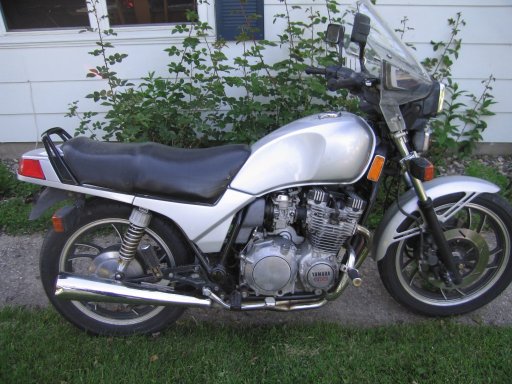 This is not so much an innovation as a project to repair a tool
for the purposes of travelling. Behold: The 1984 Yamaha Seca 750.
I picked this up early in summer '06, after completing Illinois' motorcycle
training class. I highly recommend anyone who wants to buy a bike take the
state offered classes. It offers a discount on insurance as well as making
sure you actually know how to use the bike. Important rule: Brake correctly,
and use the front brakes!
This is not so much an innovation as a project to repair a tool
for the purposes of travelling. Behold: The 1984 Yamaha Seca 750.
I picked this up early in summer '06, after completing Illinois' motorcycle
training class. I highly recommend anyone who wants to buy a bike take the
state offered classes. It offers a discount on insurance as well as making
sure you actually know how to use the bike. Important rule: Brake correctly,
and use the front brakes!
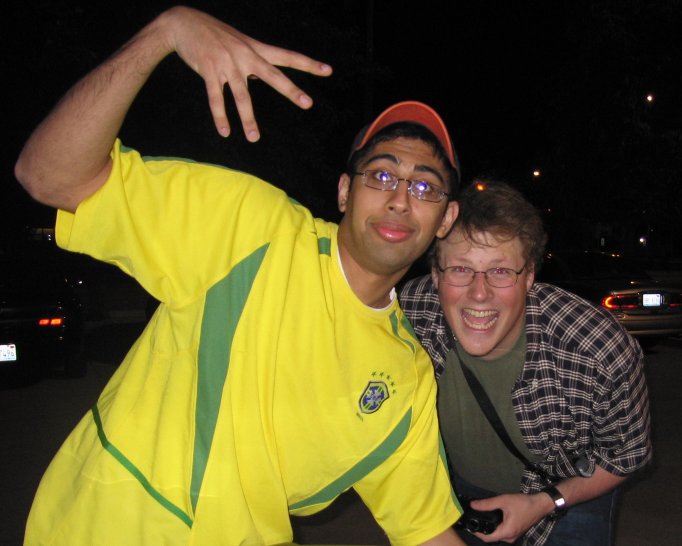 On the left in the picture is Zaid. He happened to be driving through town
during the time that I was looking for someone to help pick the bike up. We
went over to the guy's house and I tried to drive it off. The bike had some mechanical
troubles that required the replacing of sparkplugs and the rebuilding of carburetors.
The initial pickup experience allowed Zaid to tape a pretty funny video, care of his
sexy camera. To Eye of the Tiger, it depicts me driving off, and then having the
engine stop, and then again, and again. The video is not available online quite
yet, and may not ever be. We'll see.
On the left in the picture is Zaid. He happened to be driving through town
during the time that I was looking for someone to help pick the bike up. We
went over to the guy's house and I tried to drive it off. The bike had some mechanical
troubles that required the replacing of sparkplugs and the rebuilding of carburetors.
The initial pickup experience allowed Zaid to tape a pretty funny video, care of his
sexy camera. To Eye of the Tiger, it depicts me driving off, and then having the
engine stop, and then again, and again. The video is not available online quite
yet, and may not ever be. We'll see.
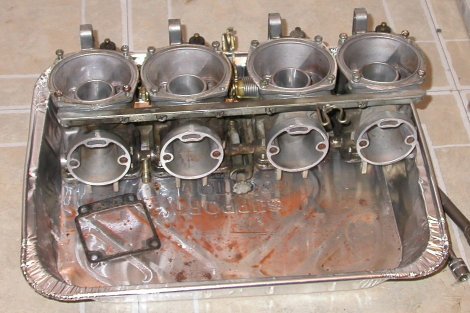 Before setting off on the roadtrip, I had to fix the rough running of the bike. Part
of this was due to bad sparkplugs, and the rest was due to the carburetors. Letting anything
sit with fuel in it for any length of time is a bad idea. The light components of the fuel
evaporate off,
leaving the rust-looking powder. It's not rust, but what motorheads call "varnish". I
spent a fair amount of time scrubbing and cleaning this stuff out. It gets in all the little
nooks and crannies of the carbs, which makes rough running and everything else. After running
my Seca a bit, one of the float valves got stuck open, meaning that fuel ran straight
through the carbs and onto the floor when the petcock was opened. Removing these
from the bike was an interesting effort. The old carb boots needed to be replaced as well. The
old ones had holes in them and were rusted to the block, which means at one point I was
drilling and tapping the cylinder casting while squatting on a milk crate. It was "old
school shade-tree mechanic."
Before setting off on the roadtrip, I had to fix the rough running of the bike. Part
of this was due to bad sparkplugs, and the rest was due to the carburetors. Letting anything
sit with fuel in it for any length of time is a bad idea. The light components of the fuel
evaporate off,
leaving the rust-looking powder. It's not rust, but what motorheads call "varnish". I
spent a fair amount of time scrubbing and cleaning this stuff out. It gets in all the little
nooks and crannies of the carbs, which makes rough running and everything else. After running
my Seca a bit, one of the float valves got stuck open, meaning that fuel ran straight
through the carbs and onto the floor when the petcock was opened. Removing these
from the bike was an interesting effort. The old carb boots needed to be replaced as well. The
old ones had holes in them and were rusted to the block, which means at one point I was
drilling and tapping the cylinder casting while squatting on a milk crate. It was "old
school shade-tree mechanic."
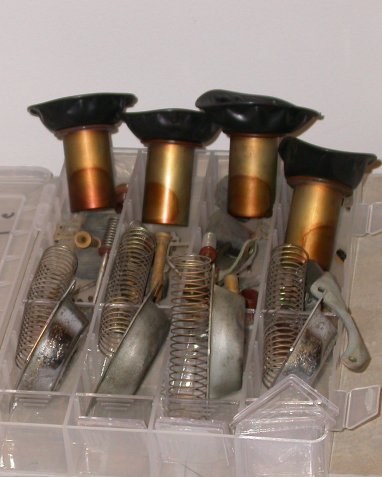 All the bits out of the carbs are depicted in the previous picture. Each carburetor has about
a dozen parts, and there are four individual carbs one for each of the four cylinders. I took
it all apart, gave it all a good scrubbing and then put it together. The work for this
project was all done in my apartment. I actually went and bought a fire extinguisher and kept
it near by, since working with gasoline filled float bowls is probably a violation of fire code.
I also was working on the bike in my then employer's parking lot, to the chagrin of the
building's operations staff. I finally get it fixed just before an important early morning
client visit. I had been given an ultimatum to get it out of there by the morning, or
the building management people were going to have it towed. So I
re-installed the carburetors in the middle of the night after riding my bicycle to work.
All the bits out of the carbs are depicted in the previous picture. Each carburetor has about
a dozen parts, and there are four individual carbs one for each of the four cylinders. I took
it all apart, gave it all a good scrubbing and then put it together. The work for this
project was all done in my apartment. I actually went and bought a fire extinguisher and kept
it near by, since working with gasoline filled float bowls is probably a violation of fire code.
I also was working on the bike in my then employer's parking lot, to the chagrin of the
building's operations staff. I finally get it fixed just before an important early morning
client visit. I had been given an ultimatum to get it out of there by the morning, or
the building management people were going to have it towed. So I
re-installed the carburetors in the middle of the night after riding my bicycle to work.
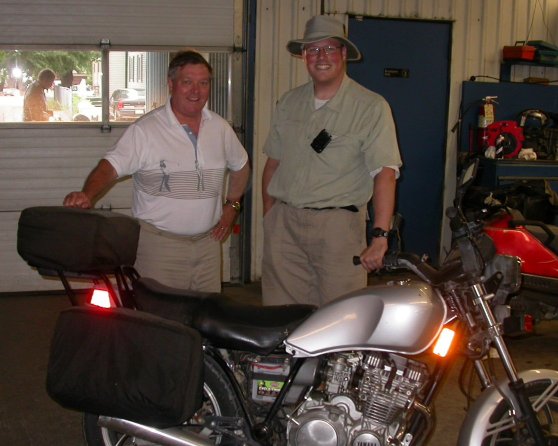 The total journey with this bike lasted only about 800 miles before I had a problem
that I chose not to fix. When I was approaching beautiful Fargo, North Dakota,
the front fork seals really went in a nasty way, and I ended up with
oil running all over the shop. I didn't repair them in advance, as I lacked the tools
to properly dissasemble the front forks of a bike with anti-dive stuff linked into
the braking system, and the previous owner said that he had had them replaced fairly
recently. I finally limped into University Motors Inc, with a mostly flat front
tire, a relatively empty gas tank, looking for help. Jack Toring and his buddies offered
to fix the thing right quick for a reasonable amount of money, but at this point I decided
that I didn't want to spend any more money on the Seca, especially with the long, lonely and
mostly up hill drive across Montana, Wyoming, and Idaho still ahead.
One of Jack's shop mechanics bought it off me, and
I went the rest of the way on the train. Eventually I would like to get another
motorcycle, using the knowledge gained from this one to choose a more appropriate bike for
me. Those people that go 1000 miles in a day, even on a nice bike, really do have asses
made of steel.
The total journey with this bike lasted only about 800 miles before I had a problem
that I chose not to fix. When I was approaching beautiful Fargo, North Dakota,
the front fork seals really went in a nasty way, and I ended up with
oil running all over the shop. I didn't repair them in advance, as I lacked the tools
to properly dissasemble the front forks of a bike with anti-dive stuff linked into
the braking system, and the previous owner said that he had had them replaced fairly
recently. I finally limped into University Motors Inc, with a mostly flat front
tire, a relatively empty gas tank, looking for help. Jack Toring and his buddies offered
to fix the thing right quick for a reasonable amount of money, but at this point I decided
that I didn't want to spend any more money on the Seca, especially with the long, lonely and
mostly up hill drive across Montana, Wyoming, and Idaho still ahead.
One of Jack's shop mechanics bought it off me, and
I went the rest of the way on the train. Eventually I would like to get another
motorcycle, using the knowledge gained from this one to choose a more appropriate bike for
me. Those people that go 1000 miles in a day, even on a nice bike, really do have asses
made of steel.

